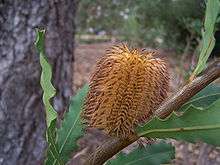Banksia quercifolia
Banksia quercifolia, commonly known as the oak-leaved banksia,[2] is a species of shrub that is endemic to the southwestern coast of Western Australia. It has smooth, greenish bark, wavy, wedge-shaped, serrated leaves, yellow, orange or brown flowers in cylindrical spikes, followed by broadly linear follicles surrounded by the remains of the flowers.
| Oak-leaved banksia | |
|---|---|
 | |
| Banksia quercifolia in Kings Park | |
| Scientific classification | |
| Kingdom: | Plantae |
| Clade: | Tracheophytes |
| Clade: | Angiosperms |
| Clade: | Eudicots |
| Order: | Proteales |
| Family: | Proteaceae |
| Genus: | Banksia |
| Subgenus: | |
| Species: | B. quercifolia |
| Binomial name | |
| Banksia quercifolia | |
| Synonyms[1] | |
Description
Banksia quercifolia is a shrub that typically that grows to a height of 0.5 to 3 m (1 ft 8 in to 9 ft 10 in) and does not form a lignotuber. It has smooth, greenish brown bark that becomes lightly tessellated and grey as it ages. It has wavy, serrated, narrow wedge-shaped leaves 30–150 mm (1.2–5.9 in) long and 10–40 mm (0.39–1.57 in) wide on a petiole 1–4 mm (0.039–0.157 in) long. The flowers are arranged in a cylindrical spike 20–100 mm (0.79–3.94 in) long and 35–45 mm (1.4–1.8 in) wide when the flowers open. The flowers are yellow, orange or brown with the perianth 23–27 mm (0.91–1.06 in) long and a stiff, gently curved pistil 17–21 mm (0.67–0.83 in) long. Flowering occurs from March to November and up to thirty-five follicles develop in each head surrounded by the remains of the flowers. The follicles are broadly linear and wavy, 15–20 mm (0.59–0.79 in) long, 11–15 mm (0.43–0.59 in) high and 4–6 mm (0.16–0.24 in) wide.[2][3][4][5]
Taxonomy
The type specimen of B. quercifolia was collected by Robert Brown from around King George Sound in December 1801[3] when Brown was the botanist aboard HMS Invesigator captained by Matthew Flinders. The species was formally described by Brown in 1810 in the Transactions of the Linnean Society of London.[6][7]
In 1869, Ferdinand von Mueller described two varieties of B. quercifolia in Fragmenta phytographiae Australiae but the names, var. integrifolia and var. quercifolia are not accepted by the Australian Plant Census.[8][9][10]
Distribution and habitat
Oak-leaved banksia occurs on the south coast of Western Australia from D'Entrecasteaux National Park in the west to Mount Manypeaks in the east where it is commonly grows in depressions, seasonally wet flats and along the margins of swamps, in white or grey peaty sandy soils.[2]
Ecology
An assessment of the potential impact of climate change on this species found that its range is likely to contract by between 50% and 80% by 2080, depending on the severity of the change.[11]
Use in horticulture
Banksia quercifolia is a fast-growing, bushy shrub that flowers within five years from seed. The flowers are sometimes hidden but are numerous and persist for many years. Because of its natural habitat, it may tolerate more moisture than other banksias. Seeds do not require any treatment, and take 25 to 40 days to germinate.[4][12]
References
- "Banksia quercifolia". Australian Plant Census. Retrieved 8 June 2020.
- "Banksia quercifolia". FloraBase. Western Australian Government Department of Parks and Wildlife.
- George, Alex S. (1999). Flora of Australia (PDF). 17B. Canberra: Australian Biological Resources Study, Canberra. p. 226. Retrieved 8 June 2020.
- George, Alex S. (1996). The Banksia Book (3rd ed.). Kenthurst, New South Wales: Kangaroo Press. pp. 82–83. ISBN 0-86417-818-2.
- George, Alex S. (1981). "The Genus Banksia L.f. (Proteaceae)". Nuytsia. 3 (3): 313–315. Retrieved 8 June 2020.
- "Banksia quercifolia". APNI. Retrieved 8 June 2020.
- Brown, Robert (1810). "On the Proteaceae of Jussieu". Transactions of the Linnean Society of London. 10 (1): 210. Retrieved 8 June 2020.
- "Banksia quercifolia var. integrifolia". APNI. Retrieved 8 June 2020.
- "Banksia quercifolia var. quercifolia". APNI. Retrieved 8 June 2020.
- von Mueller, Ferdinand (1869). Fragmenta phytographiae Australiae (Volume 7). Melbourne: Victorian Government Printer. p. 57. Retrieved 8 June 2020.
- Fitzpatrick, Matthew C.; Gove, Aaron D.; Sanders, Nathan J.; Dunn, Robert R. (2008). "Climate change, plant migration, and range collapse in a global biodiversity hotspot: the Banksia (Proteaceae) of Western Australia". Global Change Biology. 14 (6): 1–16. doi:10.1111/j.1365-2486.2008.01559.x.
- Sweedman, Luke; Merritt, David (2006). Australian seeds: a guide to their collection, identification and biology. CSIRO Publishing. p. 203. ISBN 0-643-09298-6.
- Taylor, Anne; Hopper, Stephen (1988). The Banksia Atlas (Australian Flora and Fauna Series Number 8). Canberra: Australian Government Publishing Service. ISBN 0-644-07124-9.